University Nursing Reflective Essay: Clinical Incident Analysis
VerifiedAdded on 2022/10/19
|12
|3140
|1
Essay
AI Summary
This essay analyzes a clinical incident using the clinical reasoning cycle, focusing on a case involving a 25-year-old male patient with C6 Tetraplegia admitted to the ICU following a rugby accident. The essay applies the eight stages of the clinical reasoning cycle, including considering the patient's situation, collecting cues, processing information, identifying problems, establishing roles, taking action, evaluating outcomes, and reflecting on the process and new learning. The patient experienced sudden health deterioration, suspected to be Autonomic Dysreflexia, which led to interventions such as blood pressure monitoring and removal of a constricting stocking. The essay highlights the importance of continuous monitoring and quick decision-making in nursing practice. The reflection emphasizes the need for improved knowledge and attention to detail.
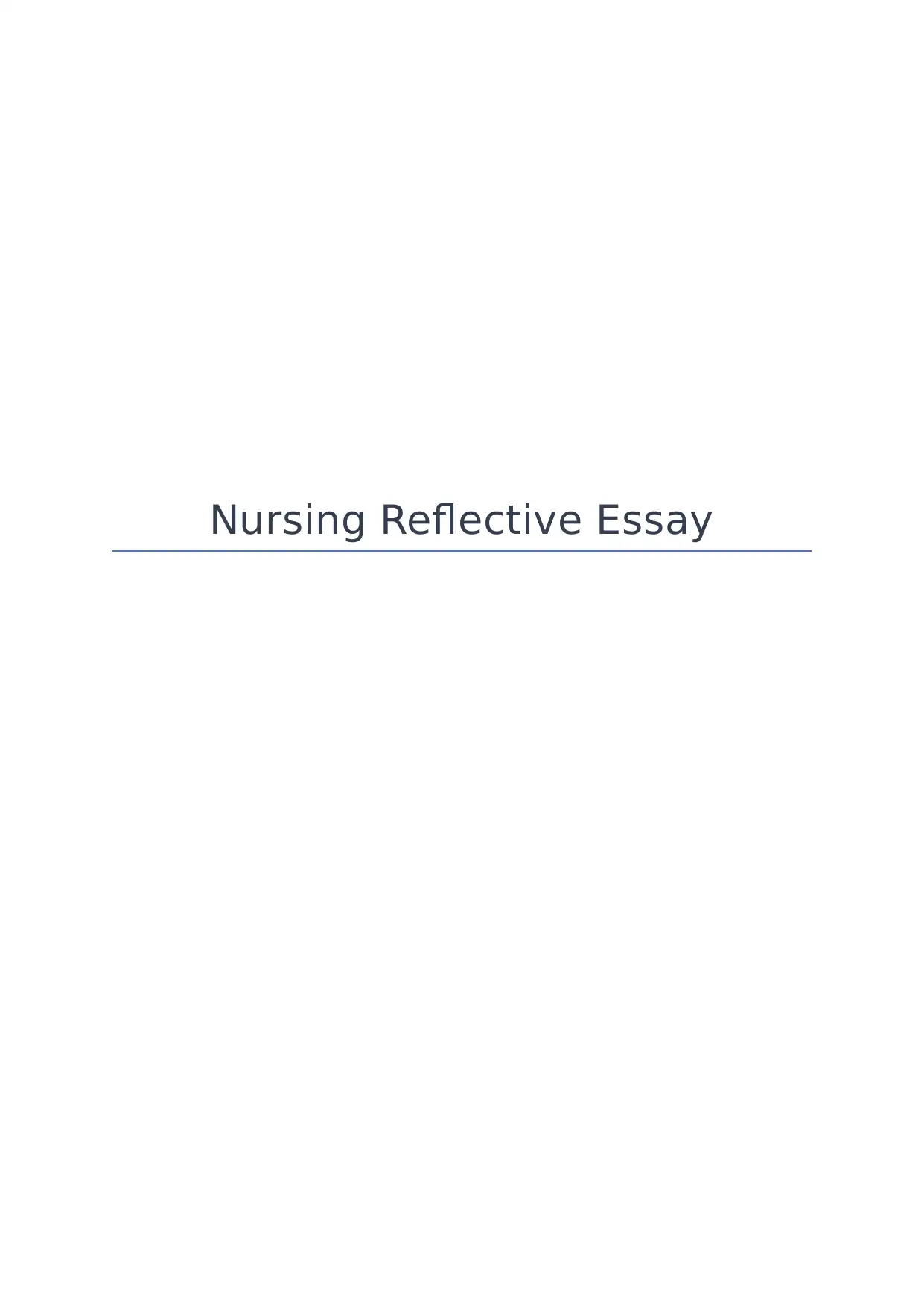
Nursing Reflective Essay
Paraphrase This Document
Need a fresh take? Get an instant paraphrase of this document with our AI Paraphraser

Table of Contents
Introduction................................................................................................................................3
Clinical Reasoning Process........................................................................................................4
Consider the situation of the patient.......................................................................................5
Collect cues and information.................................................................................................5
Process information................................................................................................................6
Identify problems or issues....................................................................................................7
Establishing roles...................................................................................................................8
Take action.............................................................................................................................8
Evaluate outcomes.................................................................................................................9
Reflect on process and new learning......................................................................................9
Conclusion................................................................................................................................10
References................................................................................................................................10
Introduction................................................................................................................................3
Clinical Reasoning Process........................................................................................................4
Consider the situation of the patient.......................................................................................5
Collect cues and information.................................................................................................5
Process information................................................................................................................6
Identify problems or issues....................................................................................................7
Establishing roles...................................................................................................................8
Take action.............................................................................................................................8
Evaluate outcomes.................................................................................................................9
Reflect on process and new learning......................................................................................9
Conclusion................................................................................................................................10
References................................................................................................................................10

Introduction
According to the National Health Workforce Innovation and Reform Strategic
Framework, the existing health workforce is not sufficiently prepared to meet the
increasingly changing dynamics of patient population of Australia. The aging population of
the country, increasing frequency of chronic disease and advancement in technology and
changes in the expectations of public indicates that the demand for healthcare services
continue to increase in Australia.Throughout the country, registered nurses (RNs)require to
meet minimum requirement of three-year’s Bachelor Degree in Nursing for the purpose of
serving the patients. The healthcare professionals require to be flexible in their approach
regarding decision-making and to ensure continuous care to the patients. The ability of the
health care professional to provide safe and high-quality healthcare relyon their ability to
think and judge, however, it is restricted due to lack of experience. Simmons (2010) stated
clinical reasoning as “a complex cognitive process that utilizes formal as well as informal
thinking strategies for the purpose of collecting and analysing information about the patients”
(Simmons, 2010). The process of clinical reasoning relies on the healthcare professional to
use intuition as well as knowledge in order to influence the process of decision-making in
case of individual patients.As critical thinking and reasoning skills are utilized in everyday
practice by RNs, this essay aims to apply eight stages of clinical reasoning cycle proposed by
Levett-Jones et al. (2010) in order to discuss and reflect on clinical decisions. It is supposed
that familiarization with the clinical reasoning cycle supports RNs in providing safe and high-
quality care to their patients. Along with it, the reflection component of the clinical reasoning
cycle will also be focused around three competency standards from the Nursing and
Midwifery Board of Australia (NMBA) for the RNs with the aim to improve the clinical
practice of the student nurses.
According to the National Health Workforce Innovation and Reform Strategic
Framework, the existing health workforce is not sufficiently prepared to meet the
increasingly changing dynamics of patient population of Australia. The aging population of
the country, increasing frequency of chronic disease and advancement in technology and
changes in the expectations of public indicates that the demand for healthcare services
continue to increase in Australia.Throughout the country, registered nurses (RNs)require to
meet minimum requirement of three-year’s Bachelor Degree in Nursing for the purpose of
serving the patients. The healthcare professionals require to be flexible in their approach
regarding decision-making and to ensure continuous care to the patients. The ability of the
health care professional to provide safe and high-quality healthcare relyon their ability to
think and judge, however, it is restricted due to lack of experience. Simmons (2010) stated
clinical reasoning as “a complex cognitive process that utilizes formal as well as informal
thinking strategies for the purpose of collecting and analysing information about the patients”
(Simmons, 2010). The process of clinical reasoning relies on the healthcare professional to
use intuition as well as knowledge in order to influence the process of decision-making in
case of individual patients.As critical thinking and reasoning skills are utilized in everyday
practice by RNs, this essay aims to apply eight stages of clinical reasoning cycle proposed by
Levett-Jones et al. (2010) in order to discuss and reflect on clinical decisions. It is supposed
that familiarization with the clinical reasoning cycle supports RNs in providing safe and high-
quality care to their patients. Along with it, the reflection component of the clinical reasoning
cycle will also be focused around three competency standards from the Nursing and
Midwifery Board of Australia (NMBA) for the RNs with the aim to improve the clinical
practice of the student nurses.
⊘ This is a preview!⊘
Do you want full access?
Subscribe today to unlock all pages.

Trusted by 1+ million students worldwide
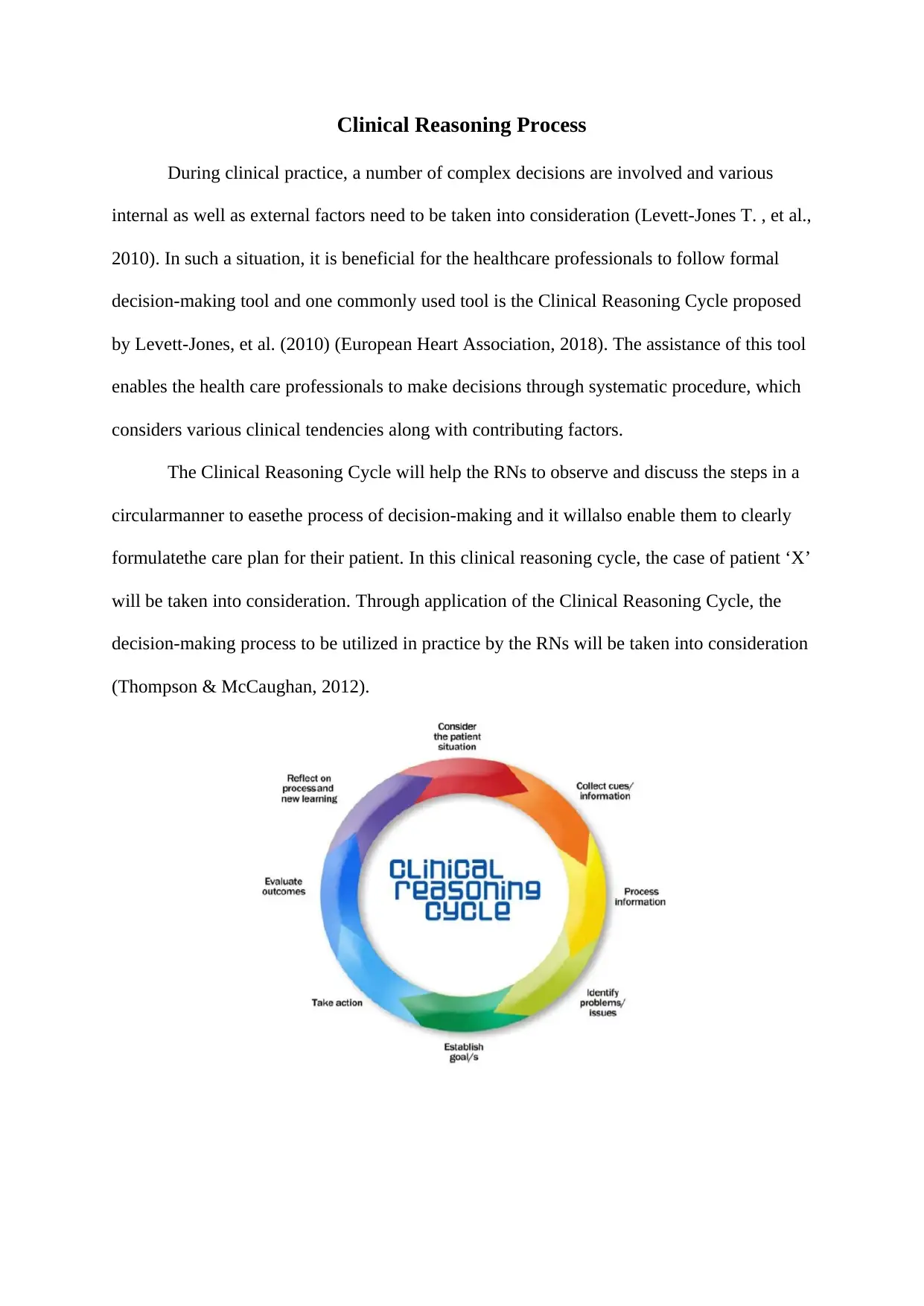
Clinical Reasoning Process
During clinical practice, a number of complex decisions are involved and various
internal as well as external factors need to be taken into consideration (Levett-Jones T. , et al.,
2010). In such a situation, it is beneficial for the healthcare professionals to follow formal
decision-making tool and one commonly used tool is the Clinical Reasoning Cycle proposed
by Levett-Jones, et al. (2010) (European Heart Association, 2018). The assistance of this tool
enables the health care professionals to make decisions through systematic procedure, which
considers various clinical tendencies along with contributing factors.
The Clinical Reasoning Cycle will help the RNs to observe and discuss the steps in a
circularmanner to easethe process of decision-making and it willalso enable them to clearly
formulatethe care plan for their patient. In this clinical reasoning cycle, the case of patient ‘X’
will be taken into consideration. Through application of the Clinical Reasoning Cycle, the
decision-making process to be utilized in practice by the RNs will be taken into consideration
(Thompson & McCaughan, 2012).
During clinical practice, a number of complex decisions are involved and various
internal as well as external factors need to be taken into consideration (Levett-Jones T. , et al.,
2010). In such a situation, it is beneficial for the healthcare professionals to follow formal
decision-making tool and one commonly used tool is the Clinical Reasoning Cycle proposed
by Levett-Jones, et al. (2010) (European Heart Association, 2018). The assistance of this tool
enables the health care professionals to make decisions through systematic procedure, which
considers various clinical tendencies along with contributing factors.
The Clinical Reasoning Cycle will help the RNs to observe and discuss the steps in a
circularmanner to easethe process of decision-making and it willalso enable them to clearly
formulatethe care plan for their patient. In this clinical reasoning cycle, the case of patient ‘X’
will be taken into consideration. Through application of the Clinical Reasoning Cycle, the
decision-making process to be utilized in practice by the RNs will be taken into consideration
(Thompson & McCaughan, 2012).
Paraphrase This Document
Need a fresh take? Get an instant paraphrase of this document with our AI Paraphraser
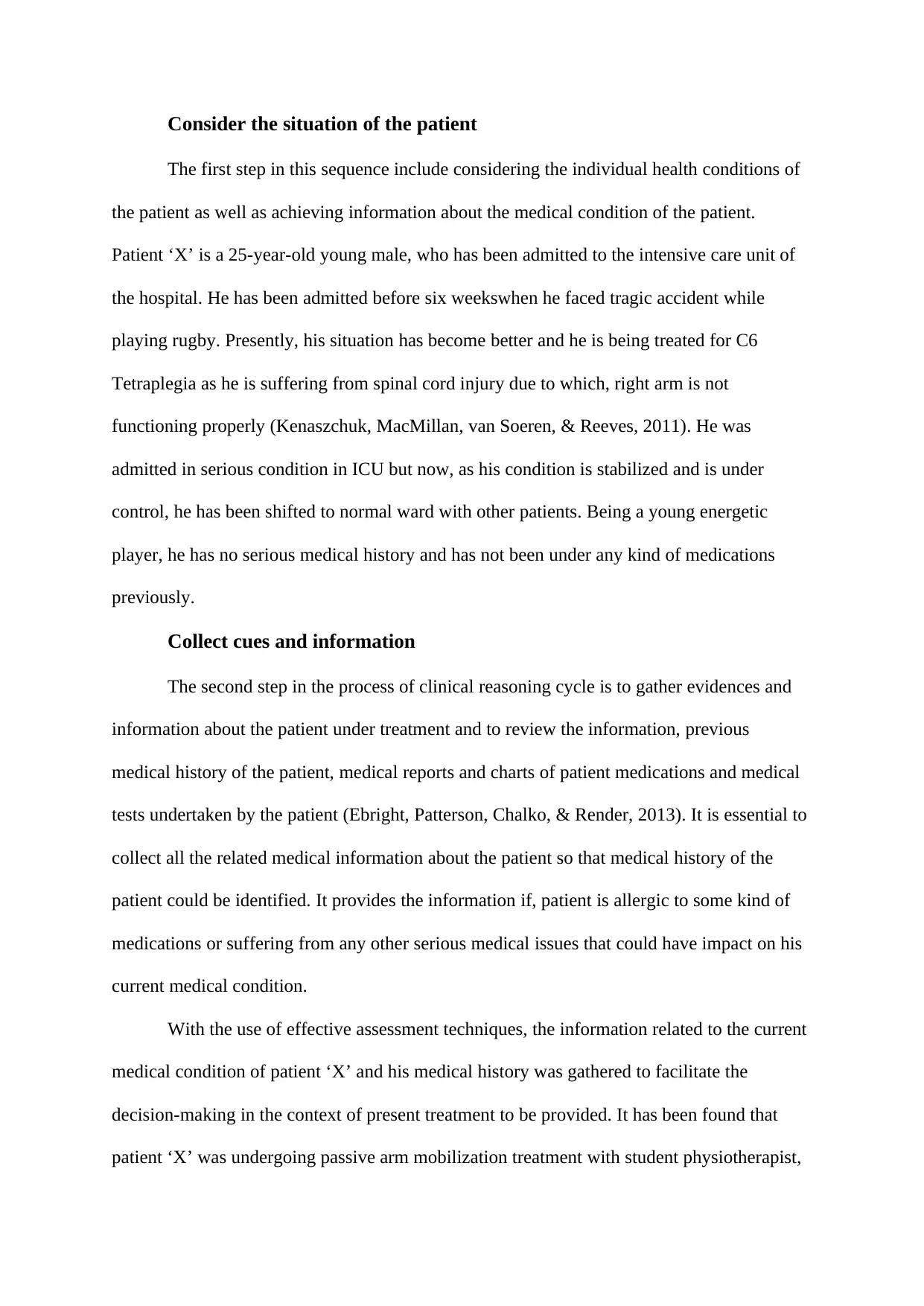
Consider the situation of the patient
The first step in this sequence include considering the individual health conditions of
the patient as well as achieving information about the medical condition of the patient.
Patient ‘X’ is a 25-year-old young male, who has been admitted to the intensive care unit of
the hospital. He has been admitted before six weekswhen he faced tragic accident while
playing rugby. Presently, his situation has become better and he is being treated for C6
Tetraplegia as he is suffering from spinal cord injury due to which, right arm is not
functioning properly (Kenaszchuk, MacMillan, van Soeren, & Reeves, 2011). He was
admitted in serious condition in ICU but now, as his condition is stabilized and is under
control, he has been shifted to normal ward with other patients. Being a young energetic
player, he has no serious medical history and has not been under any kind of medications
previously.
Collect cues and information
The second step in the process of clinical reasoning cycle is to gather evidences and
information about the patient under treatment and to review the information, previous
medical history of the patient, medical reports and charts of patient medications and medical
tests undertaken by the patient (Ebright, Patterson, Chalko, & Render, 2013). It is essential to
collect all the related medical information about the patient so that medical history of the
patient could be identified. It provides the information if, patient is allergic to some kind of
medications or suffering from any other serious medical issues that could have impact on his
current medical condition.
With the use of effective assessment techniques, the information related to the current
medical condition of patient ‘X’ and his medical history was gathered to facilitate the
decision-making in the context of present treatment to be provided. It has been found that
patient ‘X’ was undergoing passive arm mobilization treatment with student physiotherapist,
The first step in this sequence include considering the individual health conditions of
the patient as well as achieving information about the medical condition of the patient.
Patient ‘X’ is a 25-year-old young male, who has been admitted to the intensive care unit of
the hospital. He has been admitted before six weekswhen he faced tragic accident while
playing rugby. Presently, his situation has become better and he is being treated for C6
Tetraplegia as he is suffering from spinal cord injury due to which, right arm is not
functioning properly (Kenaszchuk, MacMillan, van Soeren, & Reeves, 2011). He was
admitted in serious condition in ICU but now, as his condition is stabilized and is under
control, he has been shifted to normal ward with other patients. Being a young energetic
player, he has no serious medical history and has not been under any kind of medications
previously.
Collect cues and information
The second step in the process of clinical reasoning cycle is to gather evidences and
information about the patient under treatment and to review the information, previous
medical history of the patient, medical reports and charts of patient medications and medical
tests undertaken by the patient (Ebright, Patterson, Chalko, & Render, 2013). It is essential to
collect all the related medical information about the patient so that medical history of the
patient could be identified. It provides the information if, patient is allergic to some kind of
medications or suffering from any other serious medical issues that could have impact on his
current medical condition.
With the use of effective assessment techniques, the information related to the current
medical condition of patient ‘X’ and his medical history was gathered to facilitate the
decision-making in the context of present treatment to be provided. It has been found that
patient ‘X’ was undergoing passive arm mobilization treatment with student physiotherapist,
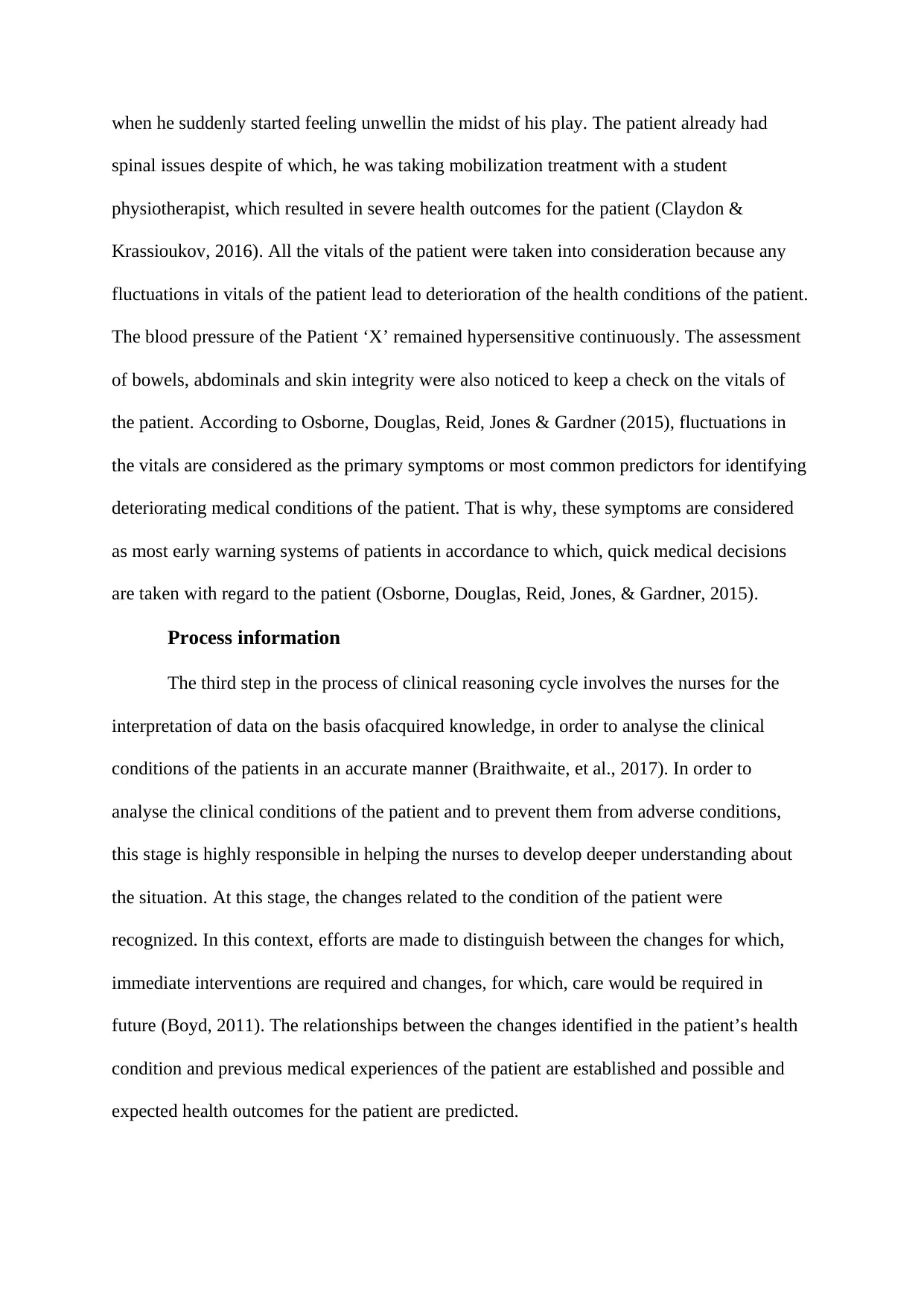
when he suddenly started feeling unwellin the midst of his play. The patient already had
spinal issues despite of which, he was taking mobilization treatment with a student
physiotherapist, which resulted in severe health outcomes for the patient (Claydon &
Krassioukov, 2016). All the vitals of the patient were taken into consideration because any
fluctuations in vitals of the patient lead to deterioration of the health conditions of the patient.
The blood pressure of the Patient ‘X’ remained hypersensitive continuously. The assessment
of bowels, abdominals and skin integrity were also noticed to keep a check on the vitals of
the patient. According to Osborne, Douglas, Reid, Jones & Gardner (2015), fluctuations in
the vitals are considered as the primary symptoms or most common predictors for identifying
deteriorating medical conditions of the patient. That is why, these symptoms are considered
as most early warning systems of patients in accordance to which, quick medical decisions
are taken with regard to the patient (Osborne, Douglas, Reid, Jones, & Gardner, 2015).
Process information
The third step in the process of clinical reasoning cycle involves the nurses for the
interpretation of data on the basis ofacquired knowledge, in order to analyse the clinical
conditions of the patients in an accurate manner (Braithwaite, et al., 2017). In order to
analyse the clinical conditions of the patient and to prevent them from adverse conditions,
this stage is highly responsible in helping the nurses to develop deeper understanding about
the situation. At this stage, the changes related to the condition of the patient were
recognized. In this context, efforts are made to distinguish between the changes for which,
immediate interventions are required and changes, for which, care would be required in
future (Boyd, 2011). The relationships between the changes identified in the patient’s health
condition and previous medical experiences of the patient are established and possible and
expected health outcomes for the patient are predicted.
spinal issues despite of which, he was taking mobilization treatment with a student
physiotherapist, which resulted in severe health outcomes for the patient (Claydon &
Krassioukov, 2016). All the vitals of the patient were taken into consideration because any
fluctuations in vitals of the patient lead to deterioration of the health conditions of the patient.
The blood pressure of the Patient ‘X’ remained hypersensitive continuously. The assessment
of bowels, abdominals and skin integrity were also noticed to keep a check on the vitals of
the patient. According to Osborne, Douglas, Reid, Jones & Gardner (2015), fluctuations in
the vitals are considered as the primary symptoms or most common predictors for identifying
deteriorating medical conditions of the patient. That is why, these symptoms are considered
as most early warning systems of patients in accordance to which, quick medical decisions
are taken with regard to the patient (Osborne, Douglas, Reid, Jones, & Gardner, 2015).
Process information
The third step in the process of clinical reasoning cycle involves the nurses for the
interpretation of data on the basis ofacquired knowledge, in order to analyse the clinical
conditions of the patients in an accurate manner (Braithwaite, et al., 2017). In order to
analyse the clinical conditions of the patient and to prevent them from adverse conditions,
this stage is highly responsible in helping the nurses to develop deeper understanding about
the situation. At this stage, the changes related to the condition of the patient were
recognized. In this context, efforts are made to distinguish between the changes for which,
immediate interventions are required and changes, for which, care would be required in
future (Boyd, 2011). The relationships between the changes identified in the patient’s health
condition and previous medical experiences of the patient are established and possible and
expected health outcomes for the patient are predicted.
⊘ This is a preview!⊘
Do you want full access?
Subscribe today to unlock all pages.

Trusted by 1+ million students worldwide
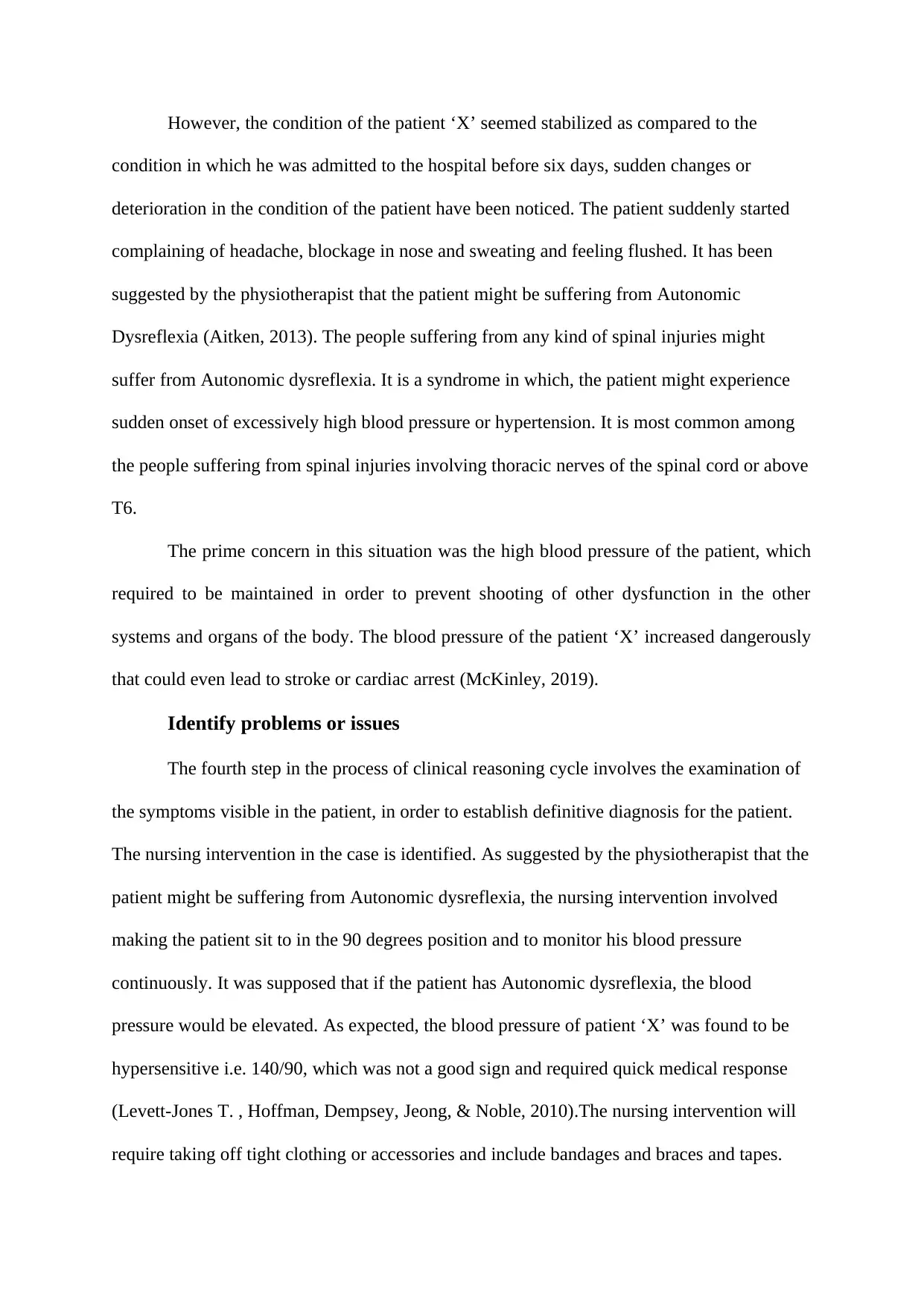
However, the condition of the patient ‘X’ seemed stabilized as compared to the
condition in which he was admitted to the hospital before six days, sudden changes or
deterioration in the condition of the patient have been noticed. The patient suddenly started
complaining of headache, blockage in nose and sweating and feeling flushed. It has been
suggested by the physiotherapist that the patient might be suffering from Autonomic
Dysreflexia (Aitken, 2013). The people suffering from any kind of spinal injuries might
suffer from Autonomic dysreflexia. It is a syndrome in which, the patient might experience
sudden onset of excessively high blood pressure or hypertension. It is most common among
the people suffering from spinal injuries involving thoracic nerves of the spinal cord or above
T6.
The prime concern in this situation was the high blood pressure of the patient, which
required to be maintained in order to prevent shooting of other dysfunction in the other
systems and organs of the body. The blood pressure of the patient ‘X’ increased dangerously
that could even lead to stroke or cardiac arrest (McKinley, 2019).
Identify problems or issues
The fourth step in the process of clinical reasoning cycle involves the examination of
the symptoms visible in the patient, in order to establish definitive diagnosis for the patient.
The nursing intervention in the case is identified. As suggested by the physiotherapist that the
patient might be suffering from Autonomic dysreflexia, the nursing intervention involved
making the patient sit to in the 90 degrees position and to monitor his blood pressure
continuously. It was supposed that if the patient has Autonomic dysreflexia, the blood
pressure would be elevated. As expected, the blood pressure of patient ‘X’ was found to be
hypersensitive i.e. 140/90, which was not a good sign and required quick medical response
(Levett-Jones T. , Hoffman, Dempsey, Jeong, & Noble, 2010).The nursing intervention will
require taking off tight clothing or accessories and include bandages and braces and tapes.
condition in which he was admitted to the hospital before six days, sudden changes or
deterioration in the condition of the patient have been noticed. The patient suddenly started
complaining of headache, blockage in nose and sweating and feeling flushed. It has been
suggested by the physiotherapist that the patient might be suffering from Autonomic
Dysreflexia (Aitken, 2013). The people suffering from any kind of spinal injuries might
suffer from Autonomic dysreflexia. It is a syndrome in which, the patient might experience
sudden onset of excessively high blood pressure or hypertension. It is most common among
the people suffering from spinal injuries involving thoracic nerves of the spinal cord or above
T6.
The prime concern in this situation was the high blood pressure of the patient, which
required to be maintained in order to prevent shooting of other dysfunction in the other
systems and organs of the body. The blood pressure of the patient ‘X’ increased dangerously
that could even lead to stroke or cardiac arrest (McKinley, 2019).
Identify problems or issues
The fourth step in the process of clinical reasoning cycle involves the examination of
the symptoms visible in the patient, in order to establish definitive diagnosis for the patient.
The nursing intervention in the case is identified. As suggested by the physiotherapist that the
patient might be suffering from Autonomic dysreflexia, the nursing intervention involved
making the patient sit to in the 90 degrees position and to monitor his blood pressure
continuously. It was supposed that if the patient has Autonomic dysreflexia, the blood
pressure would be elevated. As expected, the blood pressure of patient ‘X’ was found to be
hypersensitive i.e. 140/90, which was not a good sign and required quick medical response
(Levett-Jones T. , Hoffman, Dempsey, Jeong, & Noble, 2010).The nursing intervention will
require taking off tight clothing or accessories and include bandages and braces and tapes.
Paraphrase This Document
Need a fresh take? Get an instant paraphrase of this document with our AI Paraphraser

The nurses need toguide the patients to empty the bladder so as to reduce the pressure. The
skin of the patient should be checked for red spots indicating the patient might be suffering
from pressure injury. The conditions of the patient need to be continuously monitored
(WebMD, 2019).
Establishing roles
The fifth step in the process of clinical reasoning cycle involves planning of care with
specific outcomes in relation to the realistic timeframe. In this process, goals are developed
and prioritized accordingly. The immediate healthcare requirement in the case of patient ‘X’
is continuous monitoring of his blood pressure (Braithwaite, et al., 2017). The blood pressure
of the patient needs to be kept under control to manage his condition. It has been informedby
the doctor that the most likely cause of sudden deterioration in the condition of patient is
Autonomic dysreflexia and, continuous increase in blood could worsen the condition and
result in intracranial haemorrhage and cardiac arrhythmia (Healthwise, 2018). The goal in
front of the doctors is to identify the cause of Autonomic dysreflexia.
To take hold of the condition of the patient, continuous monitoring of blood pressure
is required. Appropriate abdominal assessment which include bladder and bowel movement
need to be assessed. The skin integrity assessment as well as other environmental factors
responsible for Autonomic dysreflexia needs to be assessed.
Take action
The sixth step in the process of clinical reasoning cyclerequires carrying out the plan
of care for the patient. The nursing intervention in this context include appropriate course of
action for the purpose of achieving desired goals. The assessment of patient ‘X’ includes
repetitive increase in blood pressure i.e. 170/130, for which doctors have suggested
administering GTN spray to the patient. The assessment of abdominals indicated no signs of
distension and bladder scan revealed 100 ml. of urine. The assessment of skin integrity
skin of the patient should be checked for red spots indicating the patient might be suffering
from pressure injury. The conditions of the patient need to be continuously monitored
(WebMD, 2019).
Establishing roles
The fifth step in the process of clinical reasoning cycle involves planning of care with
specific outcomes in relation to the realistic timeframe. In this process, goals are developed
and prioritized accordingly. The immediate healthcare requirement in the case of patient ‘X’
is continuous monitoring of his blood pressure (Braithwaite, et al., 2017). The blood pressure
of the patient needs to be kept under control to manage his condition. It has been informedby
the doctor that the most likely cause of sudden deterioration in the condition of patient is
Autonomic dysreflexia and, continuous increase in blood could worsen the condition and
result in intracranial haemorrhage and cardiac arrhythmia (Healthwise, 2018). The goal in
front of the doctors is to identify the cause of Autonomic dysreflexia.
To take hold of the condition of the patient, continuous monitoring of blood pressure
is required. Appropriate abdominal assessment which include bladder and bowel movement
need to be assessed. The skin integrity assessment as well as other environmental factors
responsible for Autonomic dysreflexia needs to be assessed.
Take action
The sixth step in the process of clinical reasoning cyclerequires carrying out the plan
of care for the patient. The nursing intervention in this context include appropriate course of
action for the purpose of achieving desired goals. The assessment of patient ‘X’ includes
repetitive increase in blood pressure i.e. 170/130, for which doctors have suggested
administering GTN spray to the patient. The assessment of abdominals indicated no signs of
distension and bladder scan revealed 100 ml. of urine. The assessment of skin integrity
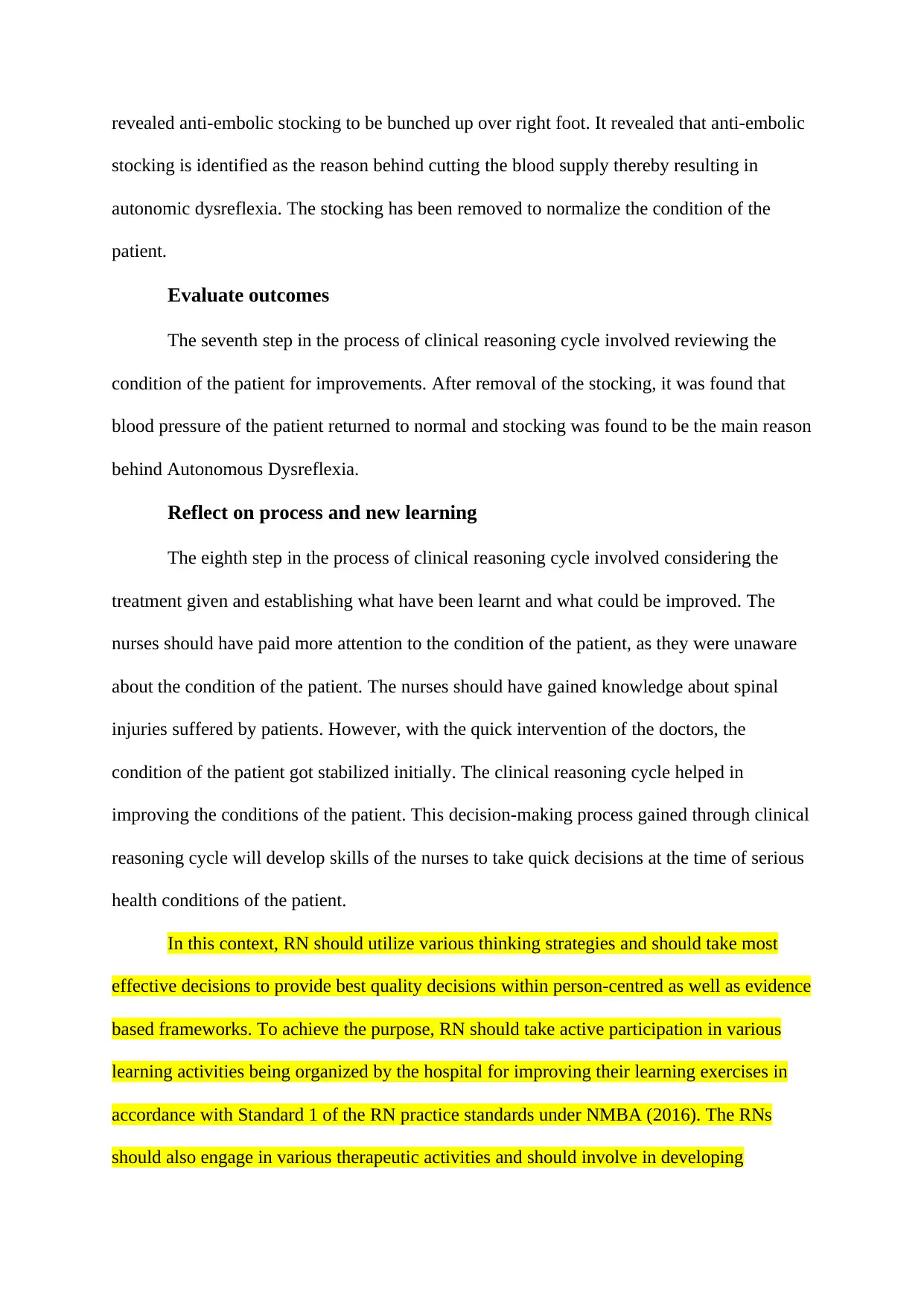
revealed anti-embolic stocking to be bunched up over right foot. It revealed that anti-embolic
stocking is identified as the reason behind cutting the blood supply thereby resulting in
autonomic dysreflexia. The stocking has been removed to normalize the condition of the
patient.
Evaluate outcomes
The seventh step in the process of clinical reasoning cycle involved reviewing the
condition of the patient for improvements. After removal of the stocking, it was found that
blood pressure of the patient returned to normal and stocking was found to be the main reason
behind Autonomous Dysreflexia.
Reflect on process and new learning
The eighth step in the process of clinical reasoning cycle involved considering the
treatment given and establishing what have been learnt and what could be improved. The
nurses should have paid more attention to the condition of the patient, as they were unaware
about the condition of the patient. The nurses should have gained knowledge about spinal
injuries suffered by patients. However, with the quick intervention of the doctors, the
condition of the patient got stabilized initially. The clinical reasoning cycle helped in
improving the conditions of the patient. This decision-making process gained through clinical
reasoning cycle will develop skills of the nurses to take quick decisions at the time of serious
health conditions of the patient.
In this context, RN should utilize various thinking strategies and should take most
effective decisions to provide best quality decisions within person-centred as well as evidence
based frameworks. To achieve the purpose, RN should take active participation in various
learning activities being organized by the hospital for improving their learning exercises in
accordance with Standard 1 of the RN practice standards under NMBA (2016). The RNs
should also engage in various therapeutic activities and should involve in developing
stocking is identified as the reason behind cutting the blood supply thereby resulting in
autonomic dysreflexia. The stocking has been removed to normalize the condition of the
patient.
Evaluate outcomes
The seventh step in the process of clinical reasoning cycle involved reviewing the
condition of the patient for improvements. After removal of the stocking, it was found that
blood pressure of the patient returned to normal and stocking was found to be the main reason
behind Autonomous Dysreflexia.
Reflect on process and new learning
The eighth step in the process of clinical reasoning cycle involved considering the
treatment given and establishing what have been learnt and what could be improved. The
nurses should have paid more attention to the condition of the patient, as they were unaware
about the condition of the patient. The nurses should have gained knowledge about spinal
injuries suffered by patients. However, with the quick intervention of the doctors, the
condition of the patient got stabilized initially. The clinical reasoning cycle helped in
improving the conditions of the patient. This decision-making process gained through clinical
reasoning cycle will develop skills of the nurses to take quick decisions at the time of serious
health conditions of the patient.
In this context, RN should utilize various thinking strategies and should take most
effective decisions to provide best quality decisions within person-centred as well as evidence
based frameworks. To achieve the purpose, RN should take active participation in various
learning activities being organized by the hospital for improving their learning exercises in
accordance with Standard 1 of the RN practice standards under NMBA (2016). The RNs
should also engage in various therapeutic activities and should involve in developing
⊘ This is a preview!⊘
Do you want full access?
Subscribe today to unlock all pages.

Trusted by 1+ million students worldwide
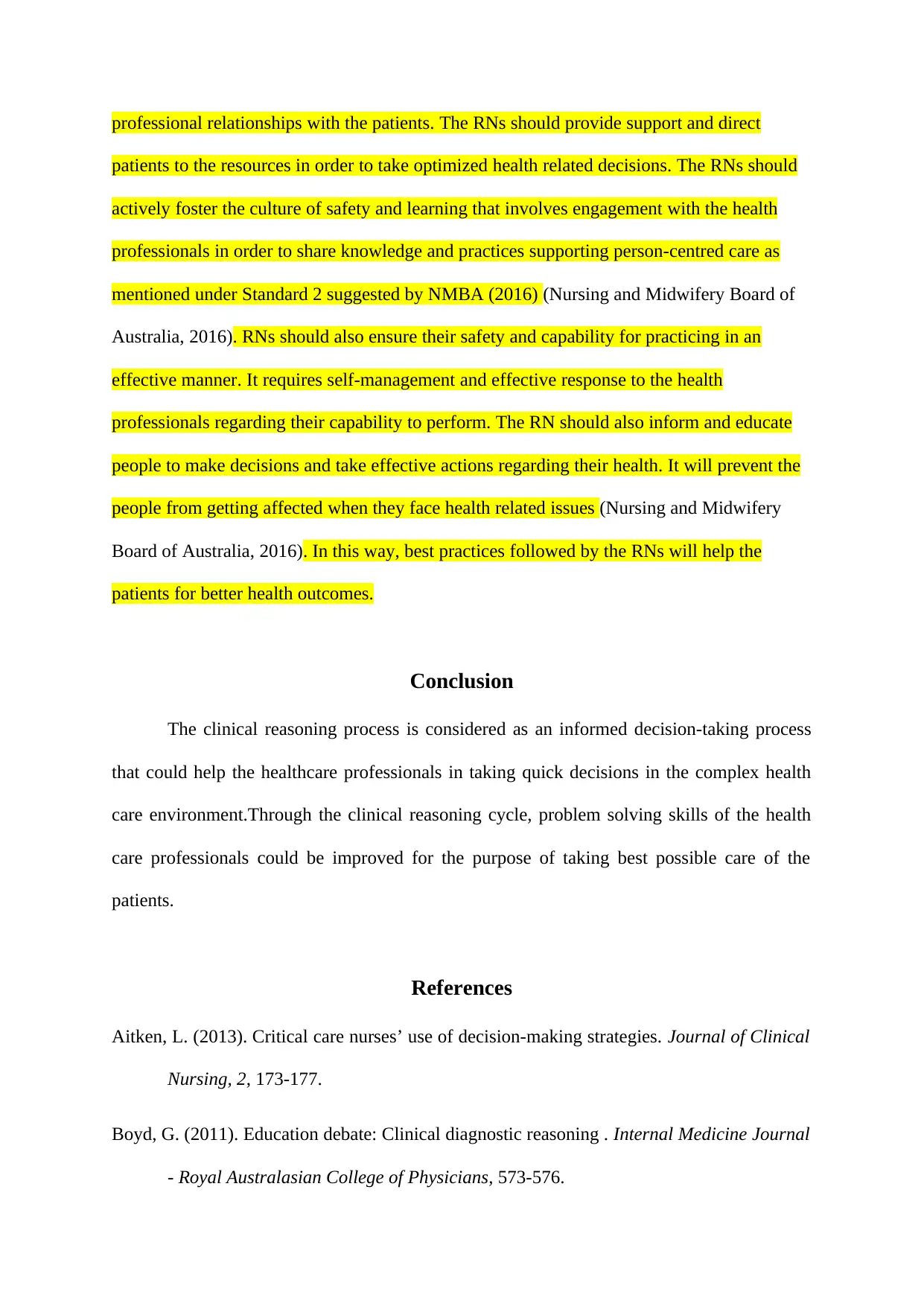
professional relationships with the patients. The RNs should provide support and direct
patients to the resources in order to take optimized health related decisions. The RNs should
actively foster the culture of safety and learning that involves engagement with the health
professionals in order to share knowledge and practices supporting person-centred care as
mentioned under Standard 2 suggested by NMBA (2016) (Nursing and Midwifery Board of
Australia, 2016). RNs should also ensure their safety and capability for practicing in an
effective manner. It requires self-management and effective response to the health
professionals regarding their capability to perform. The RN should also inform and educate
people to make decisions and take effective actions regarding their health. It will prevent the
people from getting affected when they face health related issues (Nursing and Midwifery
Board of Australia, 2016). In this way, best practices followed by the RNs will help the
patients for better health outcomes.
Conclusion
The clinical reasoning process is considered as an informed decision-taking process
that could help the healthcare professionals in taking quick decisions in the complex health
care environment.Through the clinical reasoning cycle, problem solving skills of the health
care professionals could be improved for the purpose of taking best possible care of the
patients.
References
Aitken, L. (2013). Critical care nurses’ use of decision-making strategies. Journal of Clinical
Nursing, 2, 173-177.
Boyd, G. (2011). Education debate: Clinical diagnostic reasoning . Internal Medicine Journal
- Royal Australasian College of Physicians, 573-576.
patients to the resources in order to take optimized health related decisions. The RNs should
actively foster the culture of safety and learning that involves engagement with the health
professionals in order to share knowledge and practices supporting person-centred care as
mentioned under Standard 2 suggested by NMBA (2016) (Nursing and Midwifery Board of
Australia, 2016). RNs should also ensure their safety and capability for practicing in an
effective manner. It requires self-management and effective response to the health
professionals regarding their capability to perform. The RN should also inform and educate
people to make decisions and take effective actions regarding their health. It will prevent the
people from getting affected when they face health related issues (Nursing and Midwifery
Board of Australia, 2016). In this way, best practices followed by the RNs will help the
patients for better health outcomes.
Conclusion
The clinical reasoning process is considered as an informed decision-taking process
that could help the healthcare professionals in taking quick decisions in the complex health
care environment.Through the clinical reasoning cycle, problem solving skills of the health
care professionals could be improved for the purpose of taking best possible care of the
patients.
References
Aitken, L. (2013). Critical care nurses’ use of decision-making strategies. Journal of Clinical
Nursing, 2, 173-177.
Boyd, G. (2011). Education debate: Clinical diagnostic reasoning . Internal Medicine Journal
- Royal Australasian College of Physicians, 573-576.
Paraphrase This Document
Need a fresh take? Get an instant paraphrase of this document with our AI Paraphraser
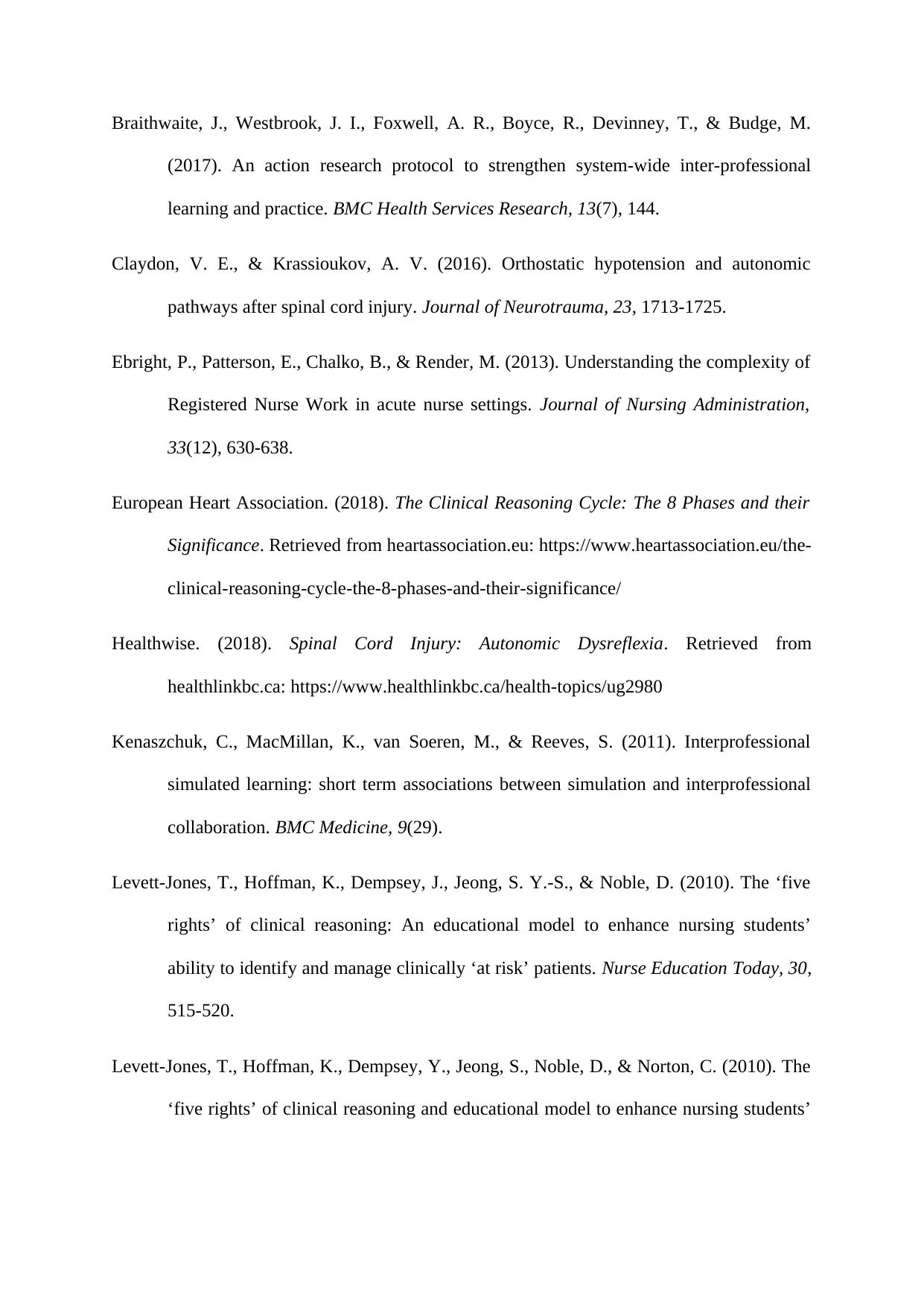
Braithwaite, J., Westbrook, J. I., Foxwell, A. R., Boyce, R., Devinney, T., & Budge, M.
(2017). An action research protocol to strengthen system-wide inter-professional
learning and practice. BMC Health Services Research, 13(7), 144.
Claydon, V. E., & Krassioukov, A. V. (2016). Orthostatic hypotension and autonomic
pathways after spinal cord injury. Journal of Neurotrauma, 23, 1713-1725.
Ebright, P., Patterson, E., Chalko, B., & Render, M. (2013). Understanding the complexity of
Registered Nurse Work in acute nurse settings. Journal of Nursing Administration,
33(12), 630-638.
European Heart Association. (2018). The Clinical Reasoning Cycle: The 8 Phases and their
Significance. Retrieved from heartassociation.eu: https://www.heartassociation.eu/the-
clinical-reasoning-cycle-the-8-phases-and-their-significance/
Healthwise. (2018). Spinal Cord Injury: Autonomic Dysreflexia. Retrieved from
healthlinkbc.ca: https://www.healthlinkbc.ca/health-topics/ug2980
Kenaszchuk, C., MacMillan, K., van Soeren, M., & Reeves, S. (2011). Interprofessional
simulated learning: short term associations between simulation and interprofessional
collaboration. BMC Medicine, 9(29).
Levett-Jones, T., Hoffman, K., Dempsey, J., Jeong, S. Y.-S., & Noble, D. (2010). The ‘five
rights’ of clinical reasoning: An educational model to enhance nursing students’
ability to identify and manage clinically ‘at risk’ patients. Nurse Education Today, 30,
515-520.
Levett-Jones, T., Hoffman, K., Dempsey, Y., Jeong, S., Noble, D., & Norton, C. (2010). The
‘five rights’ of clinical reasoning and educational model to enhance nursing students’
(2017). An action research protocol to strengthen system-wide inter-professional
learning and practice. BMC Health Services Research, 13(7), 144.
Claydon, V. E., & Krassioukov, A. V. (2016). Orthostatic hypotension and autonomic
pathways after spinal cord injury. Journal of Neurotrauma, 23, 1713-1725.
Ebright, P., Patterson, E., Chalko, B., & Render, M. (2013). Understanding the complexity of
Registered Nurse Work in acute nurse settings. Journal of Nursing Administration,
33(12), 630-638.
European Heart Association. (2018). The Clinical Reasoning Cycle: The 8 Phases and their
Significance. Retrieved from heartassociation.eu: https://www.heartassociation.eu/the-
clinical-reasoning-cycle-the-8-phases-and-their-significance/
Healthwise. (2018). Spinal Cord Injury: Autonomic Dysreflexia. Retrieved from
healthlinkbc.ca: https://www.healthlinkbc.ca/health-topics/ug2980
Kenaszchuk, C., MacMillan, K., van Soeren, M., & Reeves, S. (2011). Interprofessional
simulated learning: short term associations between simulation and interprofessional
collaboration. BMC Medicine, 9(29).
Levett-Jones, T., Hoffman, K., Dempsey, J., Jeong, S. Y.-S., & Noble, D. (2010). The ‘five
rights’ of clinical reasoning: An educational model to enhance nursing students’
ability to identify and manage clinically ‘at risk’ patients. Nurse Education Today, 30,
515-520.
Levett-Jones, T., Hoffman, K., Dempsey, Y., Jeong, S., Noble, D., & Norton, C. (2010). The
‘five rights’ of clinical reasoning and educational model to enhance nursing students’
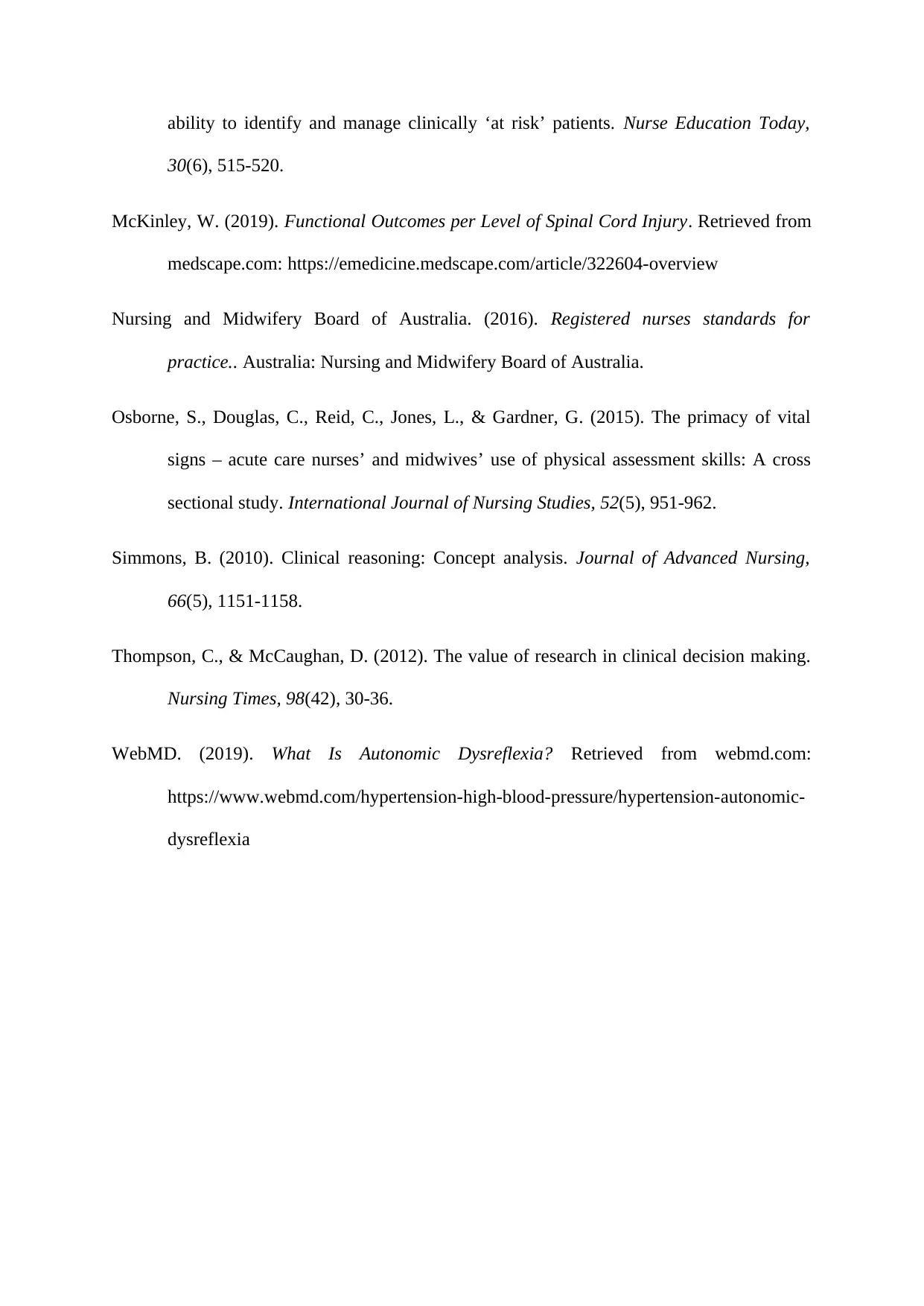
ability to identify and manage clinically ‘at risk’ patients. Nurse Education Today,
30(6), 515-520.
McKinley, W. (2019). Functional Outcomes per Level of Spinal Cord Injury. Retrieved from
medscape.com: https://emedicine.medscape.com/article/322604-overview
Nursing and Midwifery Board of Australia. (2016). Registered nurses standards for
practice.. Australia: Nursing and Midwifery Board of Australia.
Osborne, S., Douglas, C., Reid, C., Jones, L., & Gardner, G. (2015). The primacy of vital
signs – acute care nurses’ and midwives’ use of physical assessment skills: A cross
sectional study. International Journal of Nursing Studies, 52(5), 951-962.
Simmons, B. (2010). Clinical reasoning: Concept analysis. Journal of Advanced Nursing,
66(5), 1151-1158.
Thompson, C., & McCaughan, D. (2012). The value of research in clinical decision making.
Nursing Times, 98(42), 30-36.
WebMD. (2019). What Is Autonomic Dysreflexia? Retrieved from webmd.com:
https://www.webmd.com/hypertension-high-blood-pressure/hypertension-autonomic-
dysreflexia
30(6), 515-520.
McKinley, W. (2019). Functional Outcomes per Level of Spinal Cord Injury. Retrieved from
medscape.com: https://emedicine.medscape.com/article/322604-overview
Nursing and Midwifery Board of Australia. (2016). Registered nurses standards for
practice.. Australia: Nursing and Midwifery Board of Australia.
Osborne, S., Douglas, C., Reid, C., Jones, L., & Gardner, G. (2015). The primacy of vital
signs – acute care nurses’ and midwives’ use of physical assessment skills: A cross
sectional study. International Journal of Nursing Studies, 52(5), 951-962.
Simmons, B. (2010). Clinical reasoning: Concept analysis. Journal of Advanced Nursing,
66(5), 1151-1158.
Thompson, C., & McCaughan, D. (2012). The value of research in clinical decision making.
Nursing Times, 98(42), 30-36.
WebMD. (2019). What Is Autonomic Dysreflexia? Retrieved from webmd.com:
https://www.webmd.com/hypertension-high-blood-pressure/hypertension-autonomic-
dysreflexia
⊘ This is a preview!⊘
Do you want full access?
Subscribe today to unlock all pages.

Trusted by 1+ million students worldwide
1 out of 12
Related Documents
Your All-in-One AI-Powered Toolkit for Academic Success.
+13062052269
info@desklib.com
Available 24*7 on WhatsApp / Email
![[object Object]](/_next/static/media/star-bottom.7253800d.svg)
Unlock your academic potential
Copyright © 2020–2025 A2Z Services. All Rights Reserved. Developed and managed by ZUCOL.





